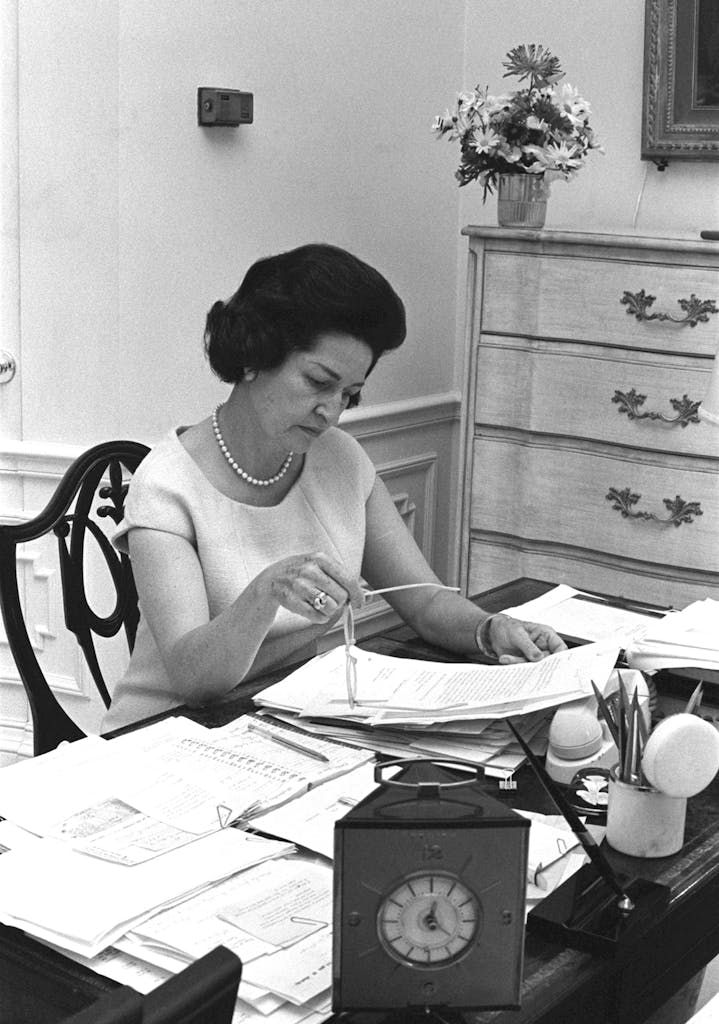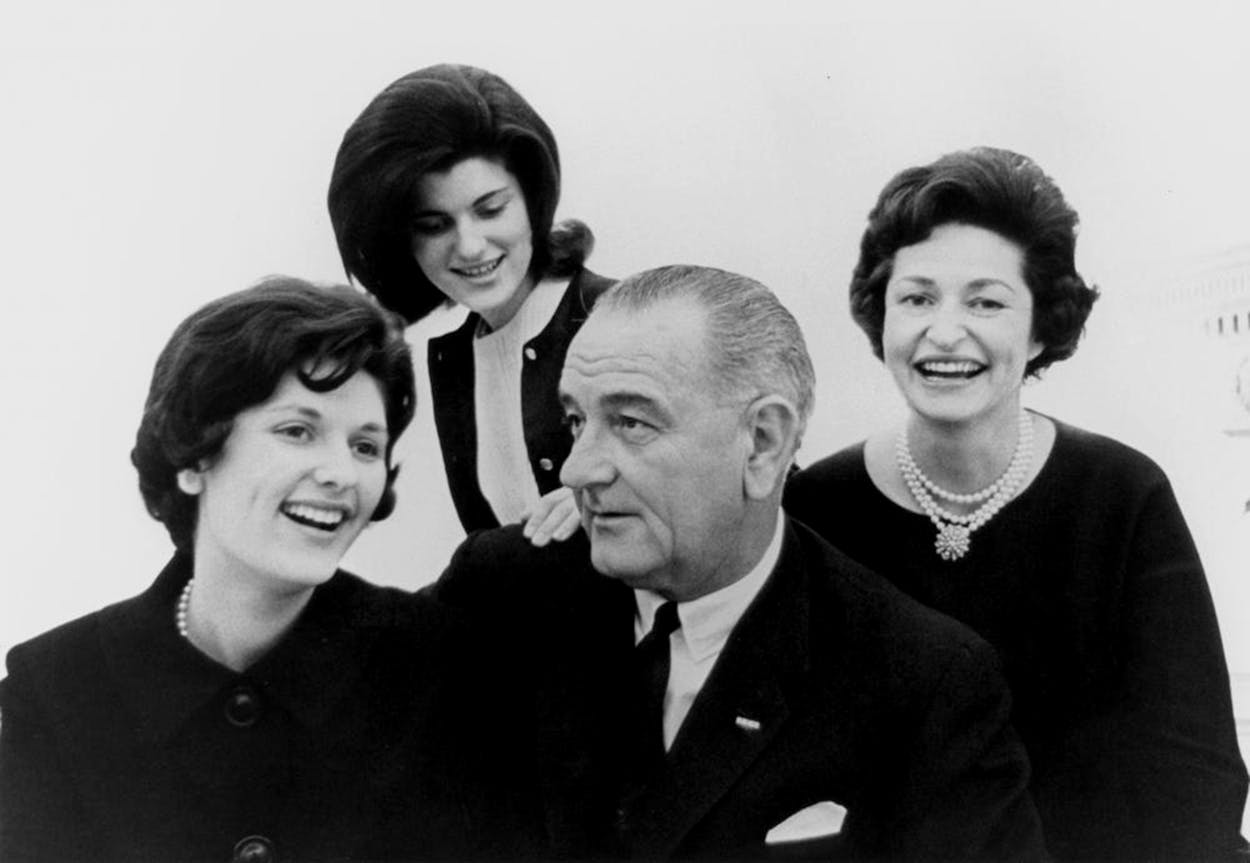My apologies, as this is a very pretentious way to begin an article, but as I strolled through the new “Lady Bird: Beyond the Wildflowers” exhibit at the LBJ Presidential Library in Austin, I couldn’t help but think of the stained-glass windows in the Notre-Dame Cathedral in Paris. When I was there several years ago, admiring how the light danced through the intricate jewel tones, I thought it cool that so many old religious sites seem to agree that the best way to celebrate your God is to build something pretty out of the materials that God has provided you. There is something inherently spiritual about physical beauty—be it man-made or in nature—and to make or keep something beautiful can be an act of gratitude, respect, and love. For all their faults, the French understand this. And you know who else did? Lady Bird Johnson.
Lady Bird worked hard to ensure that public spaces in America stayed pretty. She planted cherry blossoms all over Washington, D.C., and cleaned up our nation’s roadways with the Highway Beautification Act of 1965, which was nicknamed “Lady Bird’s Law” (she led the effort to pass the measure). If you’ve ever found yourself on a cross-country road trip and felt compelled to start whistling “America the Beautiful” as you watch prairie become desert and then mountain range, you owe no small debt of gratitude to Lady Bird. If you are from Texas, and feel a swell of pride at the bluebonnets and Indian paintbrushes that festoon our highways every spring, you have Lady Bird to thank for that, too.

This probably isn’t news to you. In this state we have a tendency to name picturesque spaces after the former first lady, like the lake in downtown Austin that she helped clean up, or the wildflower center she endowed just south of the city. But the downside to having a legacy that is so closely tied to aesthetics is that people can undervalue that and treat it superficially. “Lady Bird said she never really loved the word ‘beautification,’ but that’s the word that stuck,” exhibit curator Nikki Diller told me. “She talked about how her efforts were not merely cosmetic, that there is an intrinsic value added to the environment. It’s not just about wildflowers, it’s about nice roadsides, clean water, and clean air.”
The exhibit is subtitled “Beyond the Wildflowers” because it aims to introduce visitors to other aspects of Lady Bird Johnson’s legacy. And it does this well. There is just as much wall space dedicated to “beautification” as there is to her childhood in East Texas, her impressive collegiate career (she earned two degrees from the University of Texas, in history and journalism), her professional life (she owned radio stations and was a millionaire in her own right), the boundaries she broke in the White House (she was the first first lady to campaign without her husband and the first to hold the Bible during the inauguration), and the work she did to help establish the Head Start program for underprivileged youth. One really gets a sense of Lady Bird’s work ethic, ambition, and—at the risk of sounding too gleefully patriotic—dedication to this country.

But it’s also a beautiful exhibit. The walls are adorned with large, striking photographs of Lady Bird in picturesque locales, like the piney woods of her hometown of Karnack, or the wide-open sky and manicured lawn of the LBJ ranch in Johnson City. More than 120 photos and 80 objects are on display, including gowns from 1960s White House dinners. Visitors can also marvel at gifts given to the Johnsons from various heads of state, including an intricately carved model of the Taj Mahal. There are also a lot of Lady Bird Johnson’s old home movies on display, which have been soundtracked from the diligent audio diary she kept during her lifetime. And her voice itself is lovely to listen to; the melodic timbre of her Caddo Lake drawl only accentuates the peaceful dreaminess of the exhibit as a whole. On view until August 2023, this is the museum’s first new show after its doors were shut for more than a year during the pandemic. If you’re looking to wade back into museum-going (to wander through a cold room while you look, read, think, and admire), this is an excellent place to start.
My favorite section was right at the beginning: Lady Bird’s childhood. From the letters, images, and artifacts on display, we learn that her early life was sometimes lonely. Her mother died when Lady Bird was only five years old, and her older brothers were off at boarding school, which left their sister to entertain herself in the magical woods around their home. But it was a peaceful, adventurous childhood, and the exhibit makes clear that Lady Bird’s outlook on life was forged in those woods. “Nature became her best friend,” recalled her daughter Luci Baines Johnson. “She was somebody who appreciated the wildflowers deeply. They stirred her soul and lifted her spirits. She felt very strongly that God had given us one world and it was up to us to protect it, and if there was natural beauty that was celebrated and preserved, it would lift the spirits of all of us—that natural beauty was essential to salve the souls of human beings.”
Which is to say that when looking beyond the wildflowers of Lady Bird Johnson’s legacy, one ought not ignore them.
- More About:
- Texas History
- Lady Bird Johnson
- Austin








